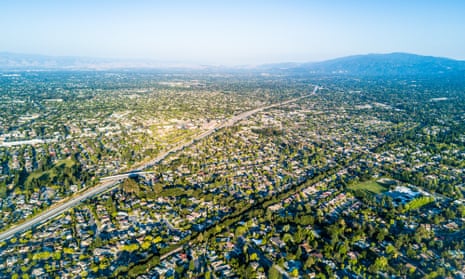Were it real, the Sultanate of Silicon Valley would be among the world’s richest countries.
Cranking out $128,308 per capita in annual gross domestic product (GDP), residents in California’s tech belt out-produce almost every nation on the planet. The valley’s output, pegged at $275bn by the federal Bureau of Economic Analysis, is higher than Finland’s.
Depending on how one counts it, Qatar’s per-capita GDP, estimated by the World Bank at $128,647 in 2017, is the world’s highest. The per-person output from Silicon Valley – more precisely, the San Jose metro area – actually outpaces Qatar’s by some measures, and puts the valley squarely in the company of such wealthy territories China’s casino peninsula Macau, estimated per-capita GDP $115,367, and Europe’s sumptuously medieval Luxembourg, estimated per-capita GDP $107,641.
Home to nearly 2 million, the San Jose metro area includes Stanford University in Palo Alto, Google’s headquarters in Mountain View and Apple HQ in Cupertino. Half the world’s tech billionaires live in Silicon Valley; a sizable portion of the remainder live just north in the San Francisco Bay Area.
San Francisco, Oakland and their suburbs comprise America’s third most productive metro area by GDP, generating $89,978 per capita, a number that puts it in the company of Singapore and Brunei.
Silicon Valley and the Bay Area only trail the Texas oil center Midland, a metro area with 165,000 residents generating $174,749 per capita GDP.
Speaking with the Mercury News, Silicon Valley’s hometown newspaper, the Bay Area Council Economic Institute president, Micah Weinberg, noted that the region’s GDP wouldn’t be so high save for areas of California with far lower GDP figures. There “really wouldn’t be Silicon Valley without the Central Valley”, Weinberg said, referring to California’s agricultural heartland.
Wealth hasn’t been without cost. Like other US high per-capita GDP areas in south-western Connecticut, Seattle and Boston, the Bay Area and Silicon Valley have seen soaring housing costs, problematic cultural shifts and political clashes tied to rising inequality. GDP, it turns out, is no way to gauge a community’s economic health.
“As a measure of output – how much stuff is being produced – GDP tells us nothing about the distribution of income from that output, which is a much more important determinant of overall wellbeing in a community,” Lew Daly, a senior policy analyst with the thinktank Demos and the co-author of Beyond GDP: New Measures for a New Economy, told the Guardian.
“GDP tells you nothing about how a community is growing,” Daly added. “If the economy is growing, that might even be a negative thing if it is growing inequitably and unsustainably. GDP doesn’t even begin to answer that question.”
Researchers like Daly advocate holistic gauges of economic health that capture more than consumption, investment and the other measures underpinning GDP figures. Sometimes, though, there is an overlap. By one more progressive metric, the Human Development Index, Silicon Valley is the nation’s most well-developed place.
